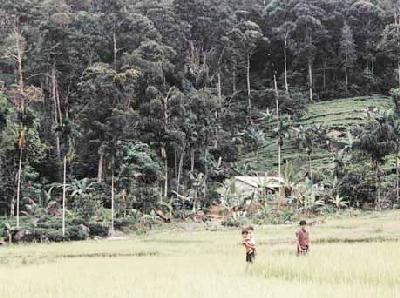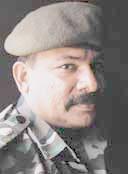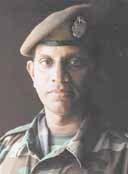
4th March 2001
Front Page|
News/Comment|
Editorial/Opinion| Business|
Sports| Mirror
Magazine

![]()








Feeding a fighter
The Sri Lanka Army Service Corps performs a little-known but important role in keeping the Army fighting fit
By Hiranthi Fernando
 Napoleon
Bonaparte, it was, who said an army marches on its stomach. Feeding an
army, particularly a fighting force, is no easy task. As the soldiers of
the Sri Lanka Army battle valiantly on the warfront, behind the scenes,
the members of the Sri Lanka Army Service Corps (SLASC) have the unenviable
task of ensuring that the troops are well fed and fighting fit.
Napoleon
Bonaparte, it was, who said an army marches on its stomach. Feeding an
army, particularly a fighting force, is no easy task. As the soldiers of
the Sri Lanka Army battle valiantly on the warfront, behind the scenes,
the members of the Sri Lanka Army Service Corps (SLASC) have the unenviable
task of ensuring that the troops are well fed and fighting fit.
 The
SLASC is responsible for providing food supplies and transport to the Army.
These two functions are of utmost importance to the smooth running of the
Army. "All other departments in the Army can close for one day, but
the SLASC cannot shut down even if there is a ceasefire or holiday,"
said Col. Kenneth Edema, Centre Commandant of the SLASC Regimental Centre
at Panagoda. "A soldier at war cannot fight without food so the supply
of food takes priority over other logistical requirements. Transport too
takes priority since the deployment of troops and provision of ammunition
depends on the transport."
The
SLASC is responsible for providing food supplies and transport to the Army.
These two functions are of utmost importance to the smooth running of the
Army. "All other departments in the Army can close for one day, but
the SLASC cannot shut down even if there is a ceasefire or holiday,"
said Col. Kenneth Edema, Centre Commandant of the SLASC Regimental Centre
at Panagoda. "A soldier at war cannot fight without food so the supply
of food takes priority over other logistical requirements. Transport too
takes priority since the deployment of troops and provision of ammunition
depends on the transport."
 At
Rs. 97 per soldier per day, the daily food bill of the Sri Lanka Army exceeds
Rs.10 million. A day's ration is counted from lunch to breakfast the next
day. Col. Edema explained that the menus are prepared every year, for the
seven days of the week and submitted to the Medical Corps for approval.
The Medical Corps specifies the amount of calories required for a soldier
at the front. Based on the needs of the soldier, there are two types of
supplies, daily supply and combat supply.
At
Rs. 97 per soldier per day, the daily food bill of the Sri Lanka Army exceeds
Rs.10 million. A day's ration is counted from lunch to breakfast the next
day. Col. Edema explained that the menus are prepared every year, for the
seven days of the week and submitted to the Medical Corps for approval.
The Medical Corps specifies the amount of calories required for a soldier
at the front. Based on the needs of the soldier, there are two types of
supplies, daily supply and combat supply.
In non-combat areas, dry rations are issued every fortnight and fresh rations, such as meat, fish, vegetables, fruits and eggs, daily. The daily allocation of Rs. 97 for a soldier is made up of Rs. 79.32 for dry rations and Rs.18.02 for fresh rations. The soldiers get chicken three days a week, with fish or egg on the other days and 225 grams of rice per meal.
"For combat supplies, we have a ration pack," Col. Edema said. "Pre-cooked meals, known as MRE (meals ready to eat) are given to soldiers engaged in operations. After many experiments, we have found a good meal packet, which the soldier only has to open and eat."
The 24-hour ration pack known as a jungle pack, is given to soldiers in operational areas, where facilities for cooking and storing food are restricted. Containing pre-cooked rice, chicken curry with potato, vegetable curry, cream crackers, cheese, instant milk powder, sugar, tea bags, table salt, glucose, Jeevani, soup cubes, orange drink, dates, match boxes, polythene bags, and toilet paper, the jungle pack is issued for limited periods until the Services Corps can establish points to supply hot meals. Special Forces troops operating ahead of Forward Defence Lines, receive an imported lightweight Survival Ration pack (SF 9) contained in a compact carton. Each slab in the carton provides sufficient nourishment for a day, so the carton can keep a soldier going for about a week.
"We are responsible for delivering the meal right up to the doorstep and we cannot fail," Col. Edema said. SLASC even goes to the recently captured areas in Jaffna. If the main supply route (MSR) is not cleared, the men are on ration packs but wherever the road is clear, fresh rations are given. "We go on the basis that a man likes to have a hot meal."
During the siege of Elephant Pass, he said, food was air-dropped although 10% to 15% of the parcels were lost. The water requirement of 20 litres per soldier per day is also delivered by the SLASC, whose responsibility it is to transport water and provide bowsers and trailers.
The Army Service Corps is made up of four regular regiments and one volunteer regiment. The Regimental Centre, 1SLASC handles the distribution for Colombo, Kandy, Nuwara Eliya and the South. The other three regular regiments based in Anuradhapura, Hingurakgoda, and Jaffna cover the rest of the country. The volunteer regiment located at Katunayake provides supplementary manpower strength.
The 3rd Regiment of the Services Corps, headquartered at Tissa Wewa, Anuradhapura, which covers supply and transport to troops deployed in Anuradhapura, Mannar, Puttalam, Vavuniya and Welioya was a hive of activity when we visited it. Lunch was being prepared in huge vessels to feed 600 soldiers, which is the daily average.
 Each
of these stations has a Composite Squadron to handle the supplies and transport.
"When the troops move forward beyond Vavuniya, it is my responsibility
to ensure they are fed and have transport," said Lt. Col. Ravi Ratnasingham,
Commanding Officer. "Movements from this side even up to Elephant
Pass are covered by us."
Each
of these stations has a Composite Squadron to handle the supplies and transport.
"When the troops move forward beyond Vavuniya, it is my responsibility
to ensure they are fed and have transport," said Lt. Col. Ravi Ratnasingham,
Commanding Officer. "Movements from this side even up to Elephant
Pass are covered by us."
Lt. Col. Ratnasingham recalled that during the Vavuniya debacle, when the troops were moving back, the Tissa Wewa Regiment, then commanded by Col. Edema had to undertake the enormous task of supplying 20,000 hot meal packs each for breakfast, lunch and dinner, for five days. The meals were cooked at the Tissa Wewa Regiment. A team was also sent to Welioya to start cooking there. Villagers and other agencies in the area helped in this massive effort.
The dry ration stores at Tissa Wewa were piled high with sacks of rice, dhal, sugar, curry stuffs, boxes of tea, milk powder, oil, etc. Store holder W.1 Nethikumaran and Supply Officer Lt. Samantha were issuing the requirements of the 3rd Armoured Corps, which was based nearby. Depending on the number of men, the requirements were worked out, weighed and issued. "We issue everything needed by the men, including gas, firewood, and matches," Lt. Col. Ratnasingham said. The Supply Squadron has to receive supplies, check for quality and balance costs so that the allocated limit is not exceeded.
The provision of transport is another important role of the SLASC. Maintenance of vehicles, transporting troops and ammunition as well as training drivers all fall under the Services Corps. Special training is given to drivers of Armoured Protected Vehicles (APVs). These drivers transport troops at the battlefront. There is a high rate of casualties and about 80 men from SLASC have lost their lives at the front, while many others have suffered injury.
Normal infantry training is conducted at Tissa Wewa for the men as well as trade training courses for cooks, drivers, clerks at the Regiment School. "Service Corps soldiers must be prepared to defend their camp,"the Commanding Officer said. When men are needed, soldiers from SLASC are also given for a fighting role. The Service Corps, though not seen in the forefront of the battle performs a very important role in providing vital support to the fighting arm of the Army. As one officer said, "It is a silent job, which rarely earns any praise. However we have to ensure quality, quantity and timely action."
![]()
Front Page| News/Comment| Editorial/Opinion| Plus| Business| Sports| Mirror Magazine
Please send your comments and suggestions on this web site to

